dec. . 01, 2024 14:26 Back to list
wiper seals
Understanding Wiper Seals Their Importance and Functionality
Wiper seals, often found in hydraulic systems, pneumatic applications, and various types of machinery, play a crucial role in ensuring the effective performance of equipment. These components are designed to prevent the ingress of contaminants and moisture while facilitating the efficient operation of moving parts. In this article, we will delve into the significance of wiper seals, their construction, how they function, and the various factors to consider when selecting the right wiper seal for specific applications.
What Are Wiper Seals?
Wiper seals, also referred to as scraper seals, are specialized sealing components typically made from elastomers or polymers, such as rubber or polyurethane. They are positioned on the outer part of cylinders, rods, or shafts to prevent dirt, dust, and other foreign particles from entering the system. This is particularly essential in hydraulic and pneumatic systems where the presence of contaminants can lead to performance degradation, wear, and ultimately, equipment failure.
Importance of Wiper Seals
The primary purpose of wiper seals is to maintain the cleanliness and integrity of the internal components of machinery. Contaminants can cause a range of issues, including increased friction, damage to moving parts, and potential catastrophic failures. By keeping the seal area clean, wiper seals help in
1. Extending Equipment Life By preventing foreign materials from entering the system, wiper seals help prolong the lifespan of critical components, thus reducing maintenance costs and downtime.
2. Enhancing Performance In hydraulic systems, for instance, clean environments contribute to smoother operation and improved efficiency, ensuring that machines perform at their best.
3. Safety In many industrial applications, malfunctioning equipment can pose serious safety risks. Implementing effective wiper seals minimizes this risk by ensuring that machinery operates safely and reliably.
Design and Functionality
Wiper seals are designed with a variety of features tailored to specific applications. The design often includes a geometry that allows the seal to effectively wipe away contaminants while maintaining a tight seal against fluids. Common designs include
wiper seals

- Single Wipers Designed for straightforward applications where simple contamination exclusion is necessary. - Double Wipers Useful in situations demanding higher protection levels, these seals consist of two wiping edges, effectively creating a barrier against both particles and liquids.
Material selection is also essential; wiper seals are often made from materials that offer high wear resistance, flexibility, and the ability to withstand extreme temperatures. Common materials include nitrile, silicone, and fluorocarbon, each chosen based on the specific operating environment and the nature of the fluids involved.
Factors to Consider When Choosing Wiper Seals
When selecting the right wiper seal, several factors should be taken into account
1. Material Compatibility The chosen material must be compatible with the fluid and operating conditions. For example, in systems that use hydraulic oils, seals made from nitrile rubber are often preferred.
2. Operating Temperature Wiper seals need to function effectively across a range of temperatures. Ensure that the selected seal can handle the extremes of the application.
3. Speed of Operation Applications operating at high speeds may require seals specifically designed to reduce friction and wear.
4. Environment Consider the external environment where the machinery operates. For dusty environments, stronger wiper seals with enhanced cleaning abilities may be necessary.
5. Installation Ensure that the design of the wiper seal allows for easy installation and maintenance, which can save time and costs.
Conclusion
Wiper seals, though often overlooked, are essential components in various mechanical systems. Their ability to protect machinery from contaminants significantly impacts operational efficiency, safety, and longevity. By understanding their function, design, and the factors influencing their selection, industry professionals can make informed decisions that enhance the performance and durability of their equipment. Investing in high-quality wiper seals is a strategic decision that pays dividends in the long run, optimizing machinery operation and reducing unplanned downtimes.
-
The Trans-formative Journey of Wheel Hub Oil Seals
NewsJun.06,2025
-
Graphene-Enhanced Oil Seals: Revolutionizing High-Pressure Oil Sealing
NewsJun.06,2025
-
Future of Hydraulic Sealing: Advanced Intelligent TCN Oil Seals
NewsJun.06,2025
-
Don’t Let a Broken TCV Oil Seal Ruin Your Day
NewsJun.06,2025
-
Bio-Inspired Dust Seals for Better Sealing Performance
NewsJun.06,2025
-
Biodegradable and Sustainable Hydraulic Seal Materials
NewsJun.06,2025
-
Top Oil Seal Solutions for Your Industrial Needs
NewsMay.22,2025
Products categories
















